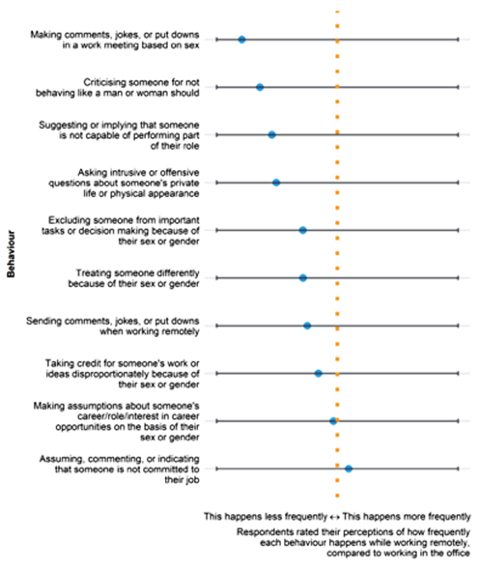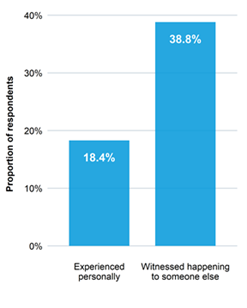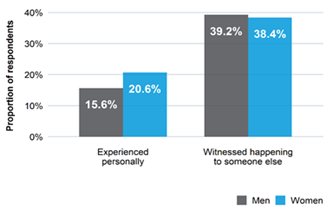Everyone should be valued and treated as equal regardless of gender. Yet in too many workplaces, sexist behaviours and sexual harassment are still a problem. In Australia, one in three people have been sexually harassed in the workplace in the past 5 years. Reducing sexist behaviours and sexual harassment in the workplace provides safer, more productive environments; improves mental health; and creates more diverse opportunities and greater empowerment for women by making it clear that they are valued in the workplace equally.
How the Pandemic Brought the Lack of Research into Sexism in Remote Workplaces to Light
Coronavirus drastically changed our working lives in 2020. As workplaces moved online, many workers found themselves almost exclusively communicating with each other through online channels including email, messaging services, and online meeting platforms.
There has been a lack of research into sexism and sexual harassment in remote workplaces, despite the current and future importance of this work. Without the knowledge of how exactly sexist and sexually harassing behaviours are manifesting in online work environments, workplaces, practitioners and policymakers are unable to design effective response and prevention strategies.
Addressing this Knowledge Gap with BIT
BIT, in partnership with Women Victoria and the Victorian Health Promotion Foundation (VicHealth), ssurveyed a representative sample of 1,109 Victorian workers about their experiences of sexism and sexual harassment while working remotely during the pandemic in order to further understand behaviours in a remote workplace setting. We asked them a series of questions exploring whether they experienced, witnessed or how they responded to 10 sexist or sexually harassing behaviours.
Across 9 out of 10 behaviours asked about, workers thought that sexist and sexually harassing behaviours occurred less frequently while working remotely compared to in the office. These can be seen in the chart below. This perceived reduction is a hopeful sign that remote working can protect workers from sexist and sexually harassing behaviours.

We can take the finding above at face value and assume that these behaviours are reduced in a remote working setting. However, it is important to remember that it may be difficult for workers to gain a clear picture of sexist behaviours and sexual harassment across a workplace while working remotely.
It is also critical to recognise that despite the perceived reduction, many workers continued to be subject to sexist and sexually harassing behaviours during online working. Our survey found that almost one in five workers experienced sexism and sexual harassment while working remotely (regardless of their gender), and one in three saw or heard about sexism and sexual harassment happening to others. We also found that women, young people and entry-level employees were more likely to experience sexism and sexual harassment, compared to men, older and more senior workers.


More work needs to be done to unpack these findings so that workplaces, practitioners and policy makers understand the prevalence of these behaviours, and what can be done to prevent sexist behaviours and sexual harassment during remote working.
Thoughts on Our Survey
Dr Karen Tindall, Principal Advisor in our Sydney office, says:
Workers should be able to attend physical workspaces or work remotely at their discretion, without being subject to gender discrimination or harassment. Remote working needs to be implemented in alongside other efforts to address this.”
VicHealth CEO Dr Sandro Demaio said businesses have a responsibility to ensure their workplace cultures are safe for women, free of sexual harassment.
Despite the progress we have made towards gender equality, women are still commonly exposed to sexist and sexually harassing behaviours in the workplace. It’s positive to see that working remotely in 2020 has protected some workers of all genders from these behaviours, however it doesn’t solve the issue. We need more employers to commit to creating workplace cultures that seek to prevent sexist behaviours and sexual harassment for staff who are both working remotely and in traditional work environments.”
In light of our survey results we recommend that workplaces should continue to offer flexible working arrangements to all workers after coronavirus related lockdowns end. However, doing so does not address the underlying causes of workers engaging in sexist and sexually harassing behaviours. While small changes can make a big difference, we need workplaces to implement holistic solutions and strategies to address sexist and sexually harassing behaviours.
What can you do about this?
If you would like to know more about what you or your colleagues can do about this, you can:
- Read our report, for the full details on the findings of our survey and further recommendations.
- Find out what’s happening in your workplace so that you can do something about it? For workplaces who wish to do research into what is happening in their specific context, we will release a workplace survey template to help them do this. This template will be available in April 2021. You can also email Emma Hunt, Senior Advisor at BIT to learn more about what we are doing here.
- Send our report to others, this will help scale interventions to address sexism and sexual harassment.
Work With Us to Address Behaviours in the Workplace
Do you want to improve gender equality in the workplace? At BIT we work across multiple industries helping to provide useful behavioural insights that can be actioned to work towards a better workplace. Get in touch to discuss any potential projects, or to enquire about our excellent training courses.





